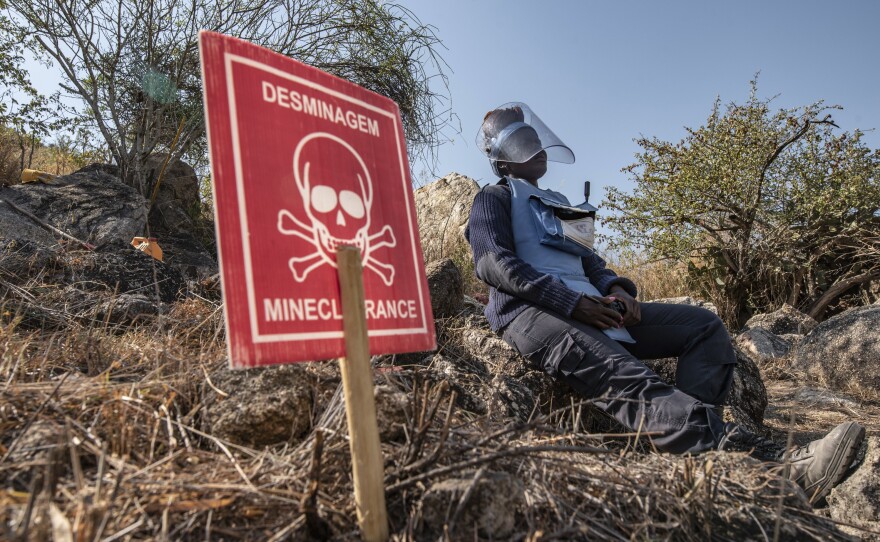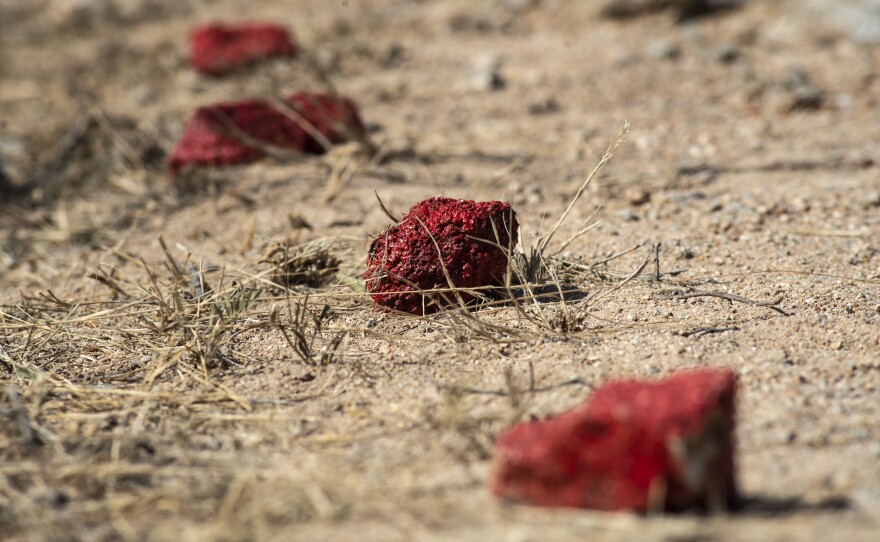Clad in sky-blue kevlar body armor with a thick protective visor over her face, 22-year-old Catarina Sanhala inches slowly forward, swinging her handheld metal detector slowly back and forth as she goes. The ground is steep and rocky and she moves with careful, deliberate steps. Falling could have consequences far beyond bruised knees or twisted ankles.
A year ago, Sanhala was enjoying a successful career as a professional handball player representing her hometown of Lobito, a port city in western Angola. That life now feels a long way off. Today, she is part of a highly trained all-female demining squad working to rid her country of deadly anti-personnel and anti-tank mines while at the same time challenging traditional notions of gender roles in this southern African nation.
"It's a very different life," says Sanhala, who works for the HALO Trust, a British nonprofit spearheading the fight against landmines in Angola. "But I wanted a challenge." She now spends most of her time living in a remote camp deep in the bush with around two dozen fellow deminers working six days a week to clear the area of mines.

Their day starts early. At 4:50 a.m. a diesel generator roars to life, flooding the women's tents with cold, blue light. By 5:20 they must be dressed and ready for work as they line up for the morning parade, shoulders huddled against the pre-dawn chill.

After that, they clamber into the back of a truck that bumps and lurches its way along a rocky track between the campsite and what HALO refers to as minefield BG262. As the first hues of sunrise begin to sweep across the landscape, the women watch a daily safety demonstration, then gather their equipment — shears, gloves, rakes, metal detectors, secateurs, wooden marker sticks, digging tools and other paraphernalia — and set off in single file into the hills.
"It's hard work, and we have to face some dangers," Sanhala says. "But I like it. I wanted to do something helpful."
It's also a job that offers a good base salary: the equivalent of about $350 a month, with higher rates for supervisors.

Back in the mid-1980s, these rugged mountains had become the latest battleground in a bitter civil war that pitted Angolan government forces, backed by Cuban troops and supported by the Soviet Union, against the UNITA rebel group, which was supported by troops from apartheid South Africa and had the backing of the U.S. and other Western powers.
In order to prevent UNITA fighters from passing through this valley and sabotaging a key railway bridge beyond it, government forces filled the area with landmines. When the conflict finally drew to a close in 2002 with the death of UNITA's leader and the surrender of his remaining forces, the vast majority of the mines remained intact in the ground.
Twenty years later, BG262 is one of more than 1,100 active minefields across the country that continue to claim lives, limit agriculture and stifle development. As of the last census in 2014, there were some 88,000 people in Angola living with injuries caused by mines and other explosive remnants of war, though the real figure is thought to be higher.


"Two cattle were blown up here in 2017," says Esperança Ngando, the supervisor for minefield BG262, indicating a large red cross on her hand-drawn map of the site. "After that the local community made the clearance request."
The minefield features some of the toughest de-mining terrain in the country, strewn with loose boulders and thick stands of prickly pear cactus plants that need to be cut back before an area can be cleared. In places, the slope is so steep that the deminers have to hack away at the dry earth with metal spikes to create footholds for themselves as they make their way forward. Despite the challenges, Ngando's teams have been making progress.
"We've cleared 19,659 square meters of land in 37 days" she says. That's a little under five acres. "And we've found four mines. We hope to be finished here by September."
Angola is littered with dozens of different types of mine made in over 20 countries. The ones discovered so far on this particular minefield are a Soviet-made model known as the POMZ-2M, an anti-personnel mine packed with explosives that stands on a wooden stake just above the surface of the ground. When triggered by a tripwire, often barely visible in the undergrowth, it sends out deadly fragments of shrapnel in all directions.

"We found the first mine here," says Ngando, pointing to a spot on her map where the curving contour lines are punctuated with four faint pencil markings . "Then we found the second one here. And while we were searching around that one we found two more." The last one had been found just the day before, she adds.
Demining is a painstaking, labor-intensive business. Working in different sections of the minefield, each deminer marks out a two meter by one meter block, hacking back the undergrowth before methodically sweeping it with a metal detector. Once the block is clear, they move on and repeat the process. Depending on the terrain and the amount of metal in the ground, a deminer might clear around 36 square yards in a day.

While the POMZ-2M mines are generally found above ground, most landmines are hidden just below the surface and are triggered by pressure from above. So the women have to proceed with extreme care. Thanks to a set of rigid safety procedures, accidents among the deminers are remarkably rare. Yet they do occur. Just the previous week a deminer in a different part of the country was injured after a mine she was trying to excavate exploded.
In order to reduce the risk of setting off a mine, the golden rule is never to approach it and begin digging from directly above. Consequently, whenever one of the women picks up a signal from her metal detector, she finds a spot 6 inches in front of the suspected mine, digs down with a series of custom made metal implements, and then excavates toward it from the side . It's exacting work that requires both stamina and intense concentration.
Until recently, the physically demanding nature of the job had fed a perception in Angola that demining work was unsuitable for women, but Ngando and her colleagues have shattered those assumptions.

She was among the first female deminers to be hired as part of HALO's 100 Women project, which aimed to continue clearing minefields while also redressing the persistent gender imbalance in demining and in post-conflict reconstruction work more broadly. Launched in 2017, the project set an initial goal of recruiting 100 Angolan women as deminers but has long since surpassed that figure. Today the organization has nearly 400 female deminers on its books in Angola, with another 35 currently in training. And while most of the more senior roles are still held by men, this imbalance is beginning to change.
"In the past, people thought this was just a man's job" says Ngando, who now has three all-female teams under her command. "But we've changed that attitude."
"We get a lot of respect, especially when we detonate things," jokes Rita Vambi, a former student and street vendor currently undergoing training for a mid-level management role with HALO. Since starting as a deminer in 2017, Vambi, whose own cousin lost an arm to a landmine as a child, has personally found and destroyed some 32 mines.

When Cecilia Manuel, a 30-year-old mother of three, signed up with HALO in 2018, some of her friends and family members thought she was mad. "Women were expected to do farm work or sell at the market or do housework" she says. "They thought this work was too dangerous for women". Four years on, many of those who once scoffed at her decision now want to become deminers themselves, Manuel says .
While she's away at work, her children stay with their grandmother. She misses them a lot, and finds herself counting down the days until her monthly visits home, but in rural Angola where steady jobs are scarce, it's a sacrifice she was willing to make. In the meantime, Manuel says she has found a new community among her fellow deminers, many of whom are in a similar position. That sense of solidarity helps her cope with the isolation of camp life and the challenging nature of the work. It is a sentiment echoed by many of the women.

"It's like a family. We're sharing new experiences together," says Catarina Sanhala, the former handball player.

By late morning, the heat on minefield BG262 has become intense. There is little shelter from the fierce sun, yet the women continue apace, working in 30- minute stints with 10 minute breaks. At one point, this routine is briefly interrupted by an explosion that reverberates off the steep walls of the valley like a distant peal of thunder. A nearby HALO team has destroyed an unexploded 60mm mortar shell discovered near the train line, explains Ngando after a brief exchange on the radio.
Before the end of the day she too must organize a demolition. The mine discovered the previous day has not yet been destroyed, and she's eager to get the job done. First, she clears the area of all deminers and posts sentries to ensure no residents wander past at the wrong moment.


Then she surrounds the mine with sandbags before preparing an explosive charge which she lays down gently along its rusting, cast iron body. Next, she lays an electric fuse and retreats to a safe distance. Moments later, there is a boom and a cloud of dust and earth rises briefly above the scrub before disappearing in the wind.
One mine at a time, the team is chipping away at a total number that once seemed insurmountable. There are still thought to be hundreds of thousands of mines across the country to be cleared, yet every month new swathes of land are being made safe.
In the south of the country, a $60 million injection of demining funds from the Angolan government has raised hopes that Cuando Cubango province, scene of some of the heaviest fighting during the civil war, could be made mine-free in the next few years. Huambo province, once one of the most densely mined parts of the country, was finally cleared of its last minefields in 2021. Now HALO hopes that, by the end of 2023, Benguela province, where minefield BG262 is located, may follow suit.

"Every time we destroy a mine I feel proud," says Cecilia Manuel. "It means we're doing our job properly. Mines are a big problem here. When you take away the mines, you make the people free."
Copyright 2023 NPR. To see more, visit https://www.npr.org. 9(MDAzMjM2NDYzMDEyMzc1Njk5NjAxNzY3OQ001))









